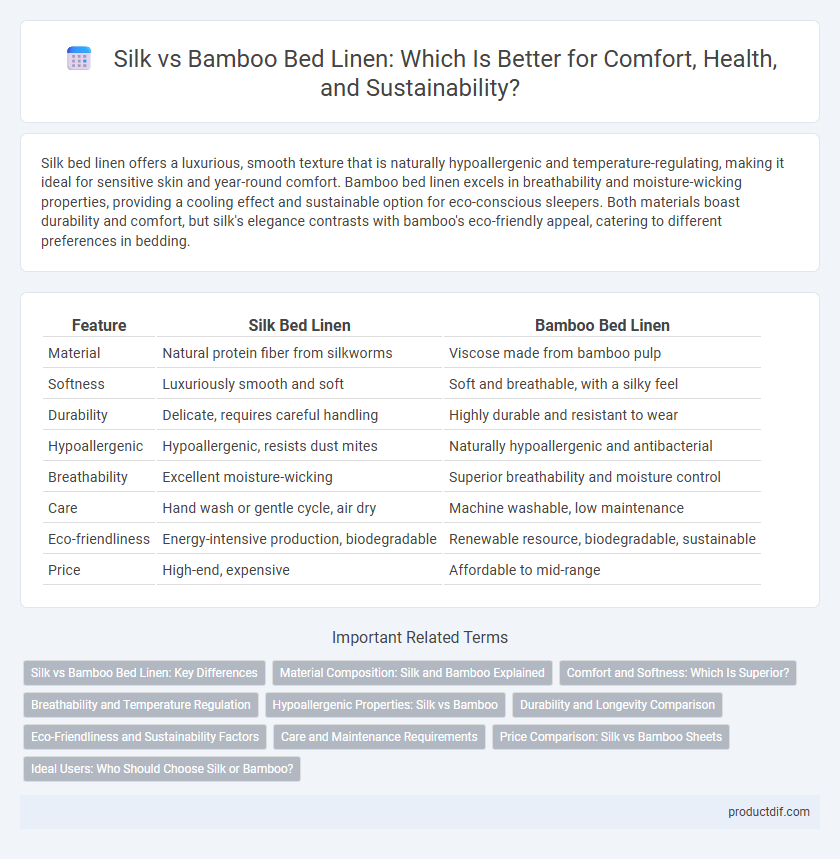Silk bed linen offers a luxurious, smooth texture that is naturally hypoallergenic and temperature-regulating, making it ideal for sensitive skin and year-round comfort. Bamboo bed linen excels in breathability and moisture-wicking properties, providing a cooling effect and sustainable option for eco-conscious sleepers. Both materials boast durability and comfort, but silk's elegance contrasts with bamboo's eco-friendly appeal, catering to different preferences in bedding.
Table of Comparison
| Feature | Silk Bed Linen | Bamboo Bed Linen |
|---|---|---|
| Material | Natural protein fiber from silkworms | Viscose made from bamboo pulp |
| Softness | Luxuriously smooth and soft | Soft and breathable, with a silky feel |
| Durability | Delicate, requires careful handling | Highly durable and resistant to wear |
| Hypoallergenic | Hypoallergenic, resists dust mites | Naturally hypoallergenic and antibacterial |
| Breathability | Excellent moisture-wicking | Superior breathability and moisture control |
| Care | Hand wash or gentle cycle, air dry | Machine washable, low maintenance |
| Eco-friendliness | Energy-intensive production, biodegradable | Renewable resource, biodegradable, sustainable |
| Price | High-end, expensive | Affordable to mid-range |
Silk vs Bamboo Bed Linen: Key Differences
Silk bed linen offers a luxurious, smooth texture with natural temperature-regulating properties ideal for both warm and cool climates, while bamboo bed linen excels in breathability and moisture-wicking, providing superior hypoallergenic benefits. Silk is more delicate, requiring gentle care to maintain its sheen and durability, whereas bamboo linen is known for its strength, easy maintenance, and eco-friendliness due to sustainable sourcing. Choosing between silk and bamboo bed linen depends on preference for opulence and softness versus eco-consciousness and enhanced breathability.
Material Composition: Silk and Bamboo Explained
Silk is a natural protein fiber produced by silkworms, known for its smooth texture and hypoallergenic properties, making it ideal for sensitive skin. Bamboo fabric is derived from bamboo pulp, processed into a soft, breathable textile with natural antibacterial and moisture-wicking capabilities. Both materials offer sustainable options, with silk being biodegradable and bamboo requiring less water and pesticides during cultivation.
Comfort and Softness: Which Is Superior?
Silk bed linen offers a luxurious, smooth texture that feels cool and gentle against the skin, making it ideal for sensitive or allergy-prone sleepers. Bamboo fabric provides exceptional softness comparable to high-quality cotton, with natural breathability and moisture-wicking properties that enhance comfort during warm nights. While both materials excel in softness, silk's unique sheen and cooling effect often make it the preferred choice for ultimate nighttime luxury.
Breathability and Temperature Regulation
Silk bed linen offers natural breathability due to its protein fibers, effectively regulating temperature by keeping you cool in summer and warm in winter. Bamboo fabric excels in moisture-wicking properties and thermal regulation, enhancing airflow and maintaining a consistently comfortable sleep environment. Both materials provide superior ventilation compared to cotton, but bamboo tends to outperform silk in heat dispersion and humidity control.
Hypoallergenic Properties: Silk vs Bamboo
Silk bed linen offers natural hypoallergenic properties by repelling dust mites, mold, and allergens, making it ideal for sensitive skin and allergy sufferers. Bamboo sheets are also hypoallergenic, featuring antimicrobial and moisture-wicking abilities that reduce bacteria and prevent irritation. Both materials provide excellent allergy protection, with silk excelling in allergen resistance and bamboo offering enhanced breathability and moisture control.
Durability and Longevity Comparison
Silk bed linen offers exceptional durability due to its tightly woven fibers and natural protein structure, maintaining strength even after multiple washes. Bamboo textiles demonstrate impressive longevity with their moisture-resistant and antimicrobial properties, reducing fabric degradation over time. Comparing both, silk provides a luxurious, long-lasting feel ideally suited for delicate care, while bamboo excels in resilience for everyday use with sustainable benefits.
Eco-Friendliness and Sustainability Factors
Silk production involves harvesting silkworm cocoons, which requires significant water and energy, but it is biodegradable and long-lasting, contributing to sustainability. Bamboo fabric is derived from fast-growing bamboo plants, requiring minimal pesticides and water, making it highly eco-friendly and renewable. Both materials offer sustainable benefits, with bamboo excelling in resource efficiency and silk valued for its natural biodegradability.
Care and Maintenance Requirements
Silk bed linen demands gentle hand washing or delicate machine cycles with mild detergent, avoiding direct sunlight to preserve its natural fibers and sheen. Bamboo bed linen offers easier maintenance, as it is machine washable at lower temperatures and resists wrinkles and shrinkage. Both materials require air drying rather than tumble drying to maintain fabric integrity and prolong lifespan.
Price Comparison: Silk vs Bamboo Sheets
Silk sheets typically command a higher price due to the labor-intensive process of harvesting and weaving natural silk fibers, often ranging from $150 to $500 for a full set. Bamboo sheets offer a more affordable alternative, with prices usually between $40 and $150, benefiting from sustainable production methods and rapid bamboo growth. Consumers seeking luxury and durability may prefer silk despite the cost, while budget-conscious buyers often opt for bamboo for its softness and eco-friendly appeal.
Ideal Users: Who Should Choose Silk or Bamboo?
Silk bed linen is ideal for individuals with sensitive skin or allergies due to its hypoallergenic and temperature-regulating properties, providing a luxurious, smooth texture that helps reduce friction and skin irritation. Bamboo bed linen suits eco-conscious users seeking sustainable, breathable fabrics with natural moisture-wicking and antibacterial benefits, making it perfect for hot sleepers and those prone to night sweats. Both materials offer unique comfort advantages, but silk excels in elegance and temperature control while bamboo prioritizes environmental impact and moisture management.
Silk vs Bamboo Infographic

 productdif.com
productdif.com